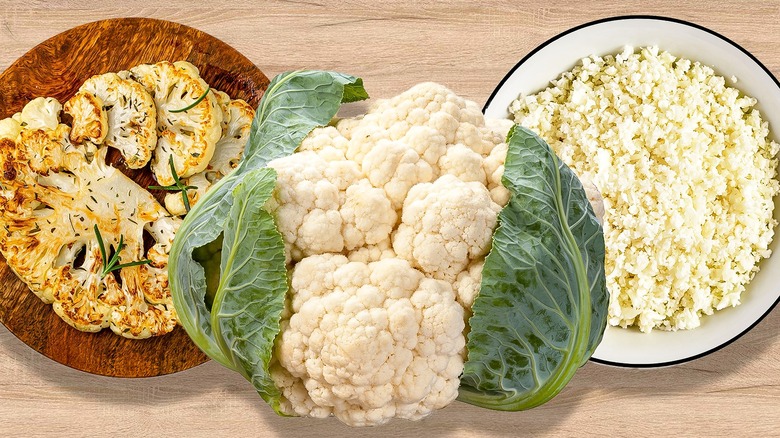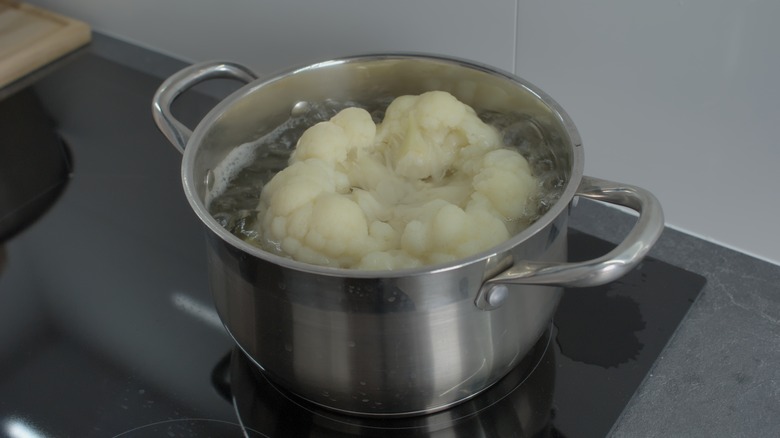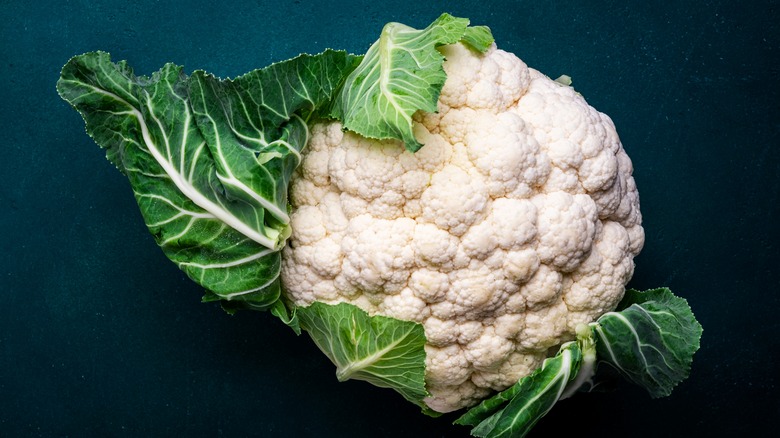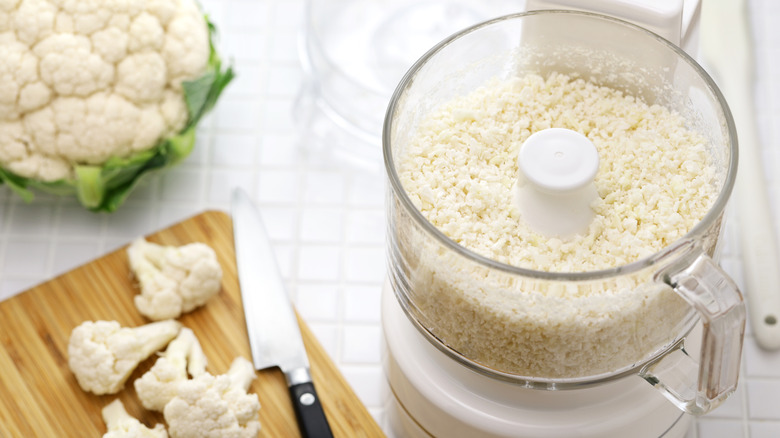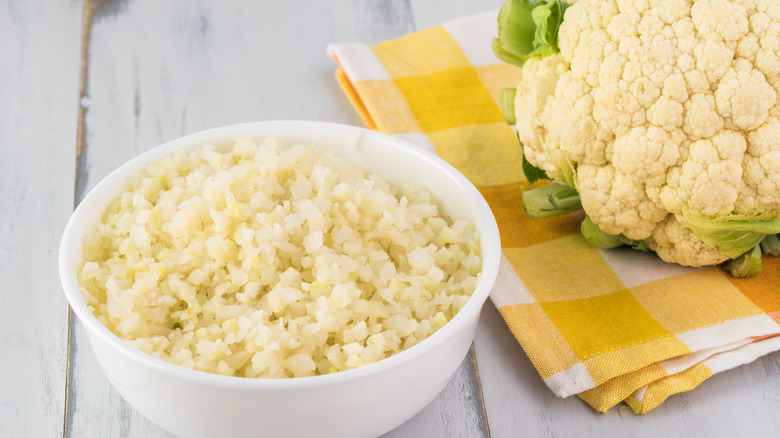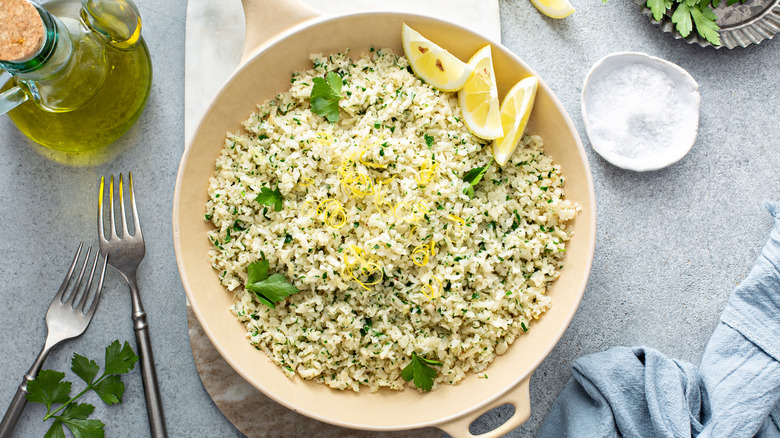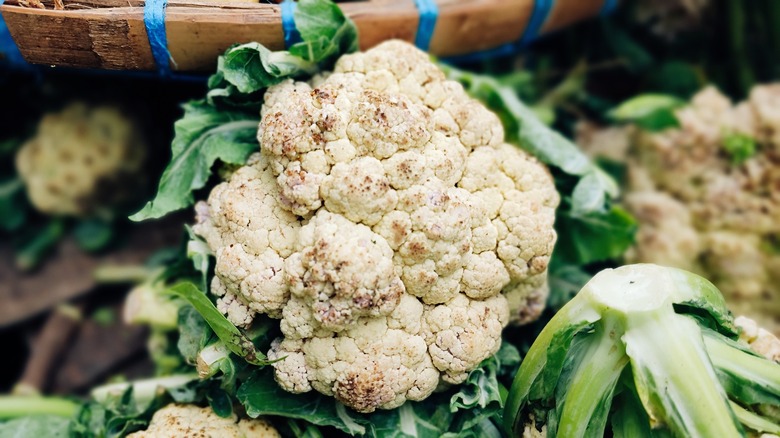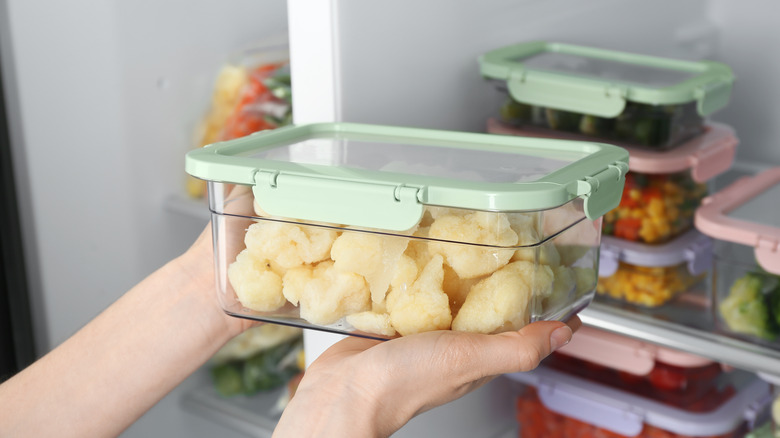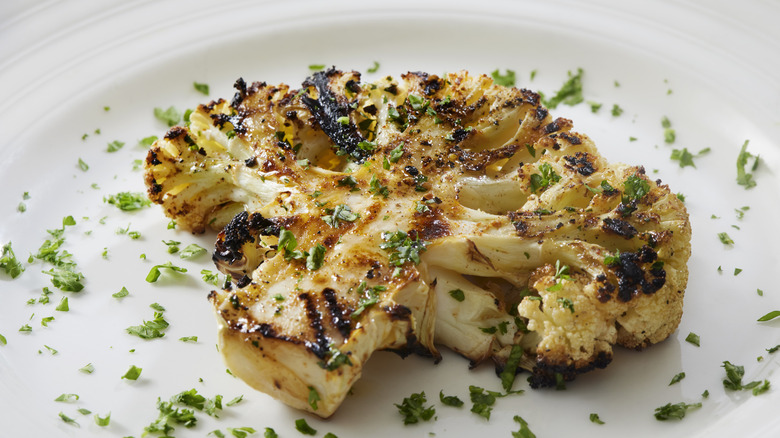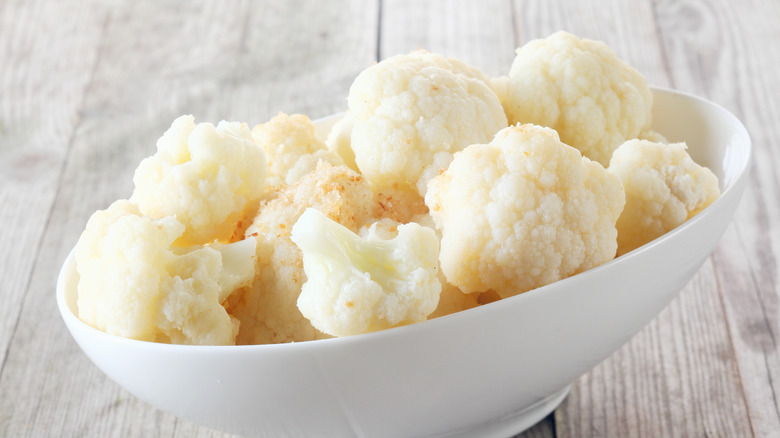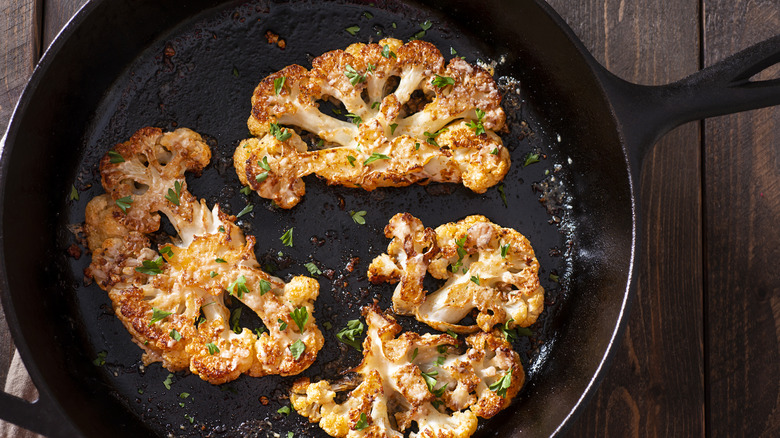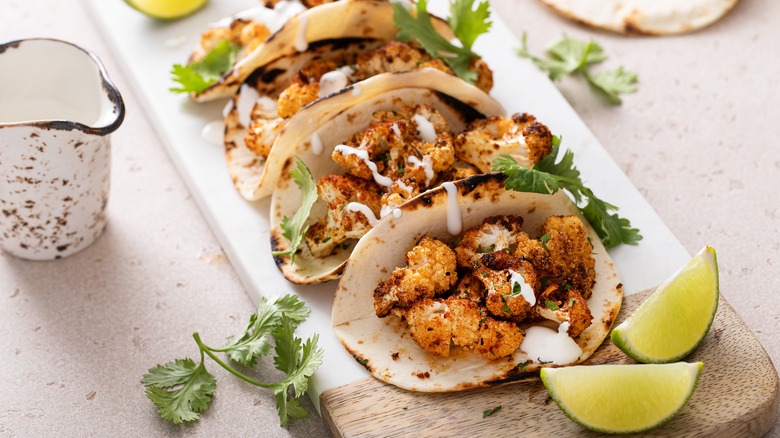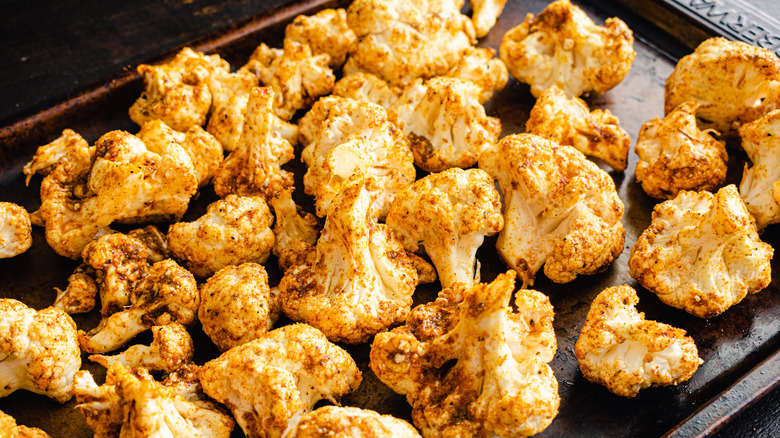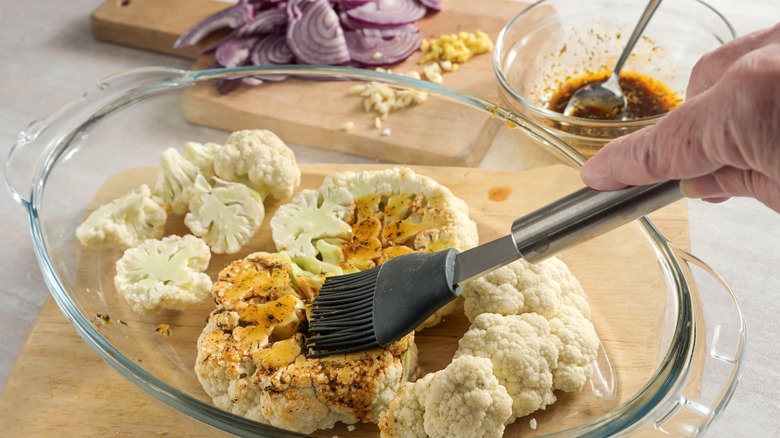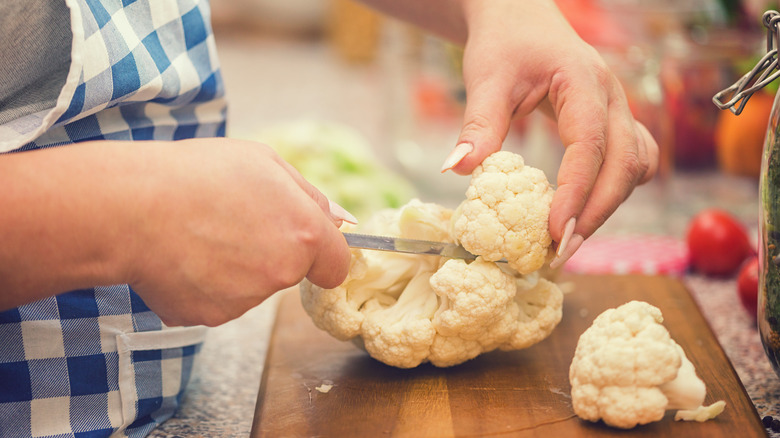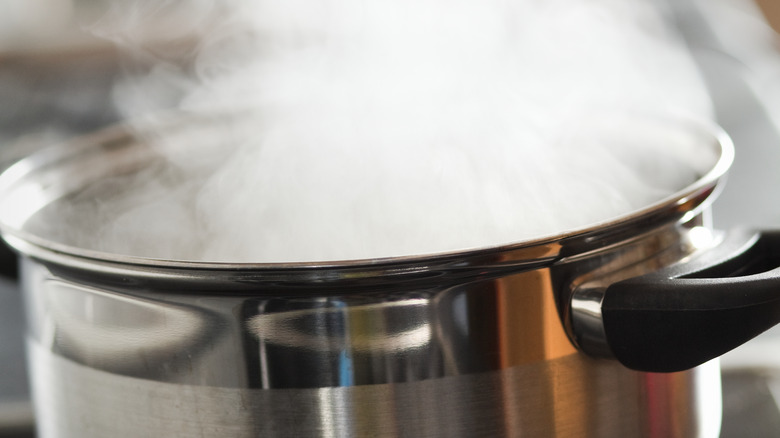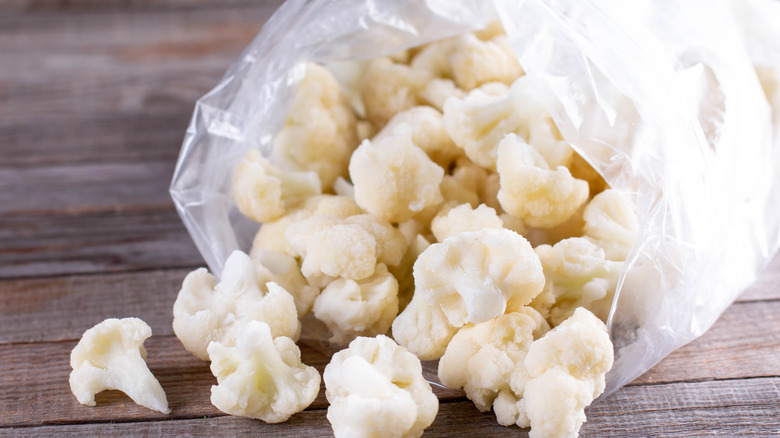18 Tips You Need When Cooking With Cauliflower
Cauliflower is a vegetable that doesn't seem to be waning in popularity anytime soon. This humble Brassica is closely related to the broccoli, cabbage, and Brussels sprout plant — but it is set apart because of its pale white head and relatively bleak flavor. Cauliflower can be prepared in many different ways and found across regional cuisines, from curries to soups, and has become a popular replacement for wheat flour in foods like pizza crust. We would be remiss if we didn't mention the rise of riced cauliflower as a replacement for the traditional starch. But no matter what kind of cauliflower recipes you try, you may encounter hurdles in preparing, cooking, and storing it.
To help you build a positive rapport with this star-struck vegetable, we've curated a list of our top tips for working with it. You can utilize these pointers whether you're firing up your grill, roasting vegan steaks on a baking sheet, or serving a dish as a simple side to your meal.
1. Select a firm head of cauliflower
Finding quality produce requires a keen eye and awareness of your senses. It's often easy to pick bananas without speckles and fruits without bruises, but can the same apply to a vegetable like cauliflower?
There are some clear indicators that separate a fresh head from one that has been on the produce shelf a bit too long. When buying a head of cauliflower from the store, look for one that is firm to the touch rather than soft and squishy. The color should be a pale white without any signs of bruising or brown spots. You can also take a peek at the leaves, which should look healthy and free from any holes (which may suggest pests or decay). Lastly, give the vegetable a whiff to see if there are any unpleasant odors.
2. Boil your cauliflower before you roast it
Roasted cauliflower is one of the best ways to prepare this cruciferous vegetable. You can add your favorite seasonings to match whatever you're serving it with, and if you dress it up enough, you can also make an entire meal out of a head. But if your cauliflower isn't soft when you bite into it, no amount of seasoning is going to save it and make it palatable.
For the most tender roasted cauliflower, parboil the head before popping it in the oven. Fill a pot with salted water and submerge the entire head for about 12 minutes. Depending on the size and shape of your pot, you may need to add a lid or a plate to the top to keep it from floating. You'll know that your cauliflower is good to go when you can easily stick a fork through it. After removing it from the water, let it dry for a little bit before seasoning it and moving forward with your recipe.
3. Find ways to repurpose your stems and leaves
Every home cook should try to avoid food waste. And when it comes to cauliflower, there seems to be a lot of it. Not many people use the leaves and green stems, while others may even just eat the puffy tops of the florets rather than the little stalks.
But, there is a way to utilize these forgotten parts of the plant. You should never throw away cauliflower leaves and stems because you can slice them up and add them to your favorite recipes. Granted, the stems will be a bit harder in texture than the crown, so you will have to cook them longer than the soft florets. Once they're sliced and prepared, stir them into a curry for extra fiber, or blend them with the florets into your soups. You can also batter and deep fry your stems for an easy appetizer.
4. Don't make your cauliflower rice too far in advance
Ricing is one of the simplest and most versatile preparation methods for cauliflower. All you need to do is pop the raw, washed heads into your food processor and pulse until they resemble a small, grainy consistency. If you don't have this appliance handy, you can also use an old-school box grater. Regardless of the tool you use, you may be making a big mistake with this veggie-forward side: making riced cauliflower too far ahead of time.
If you make your rice too far in advance, you'll risk stinking up your entire kitchen. Brassicas, which include cauliflower, broccoli, and Brussels sprouts, release a sulfur-rich gas when they're left to sit for a period of time. In general, your cauliflower rice should only be made a day ahead of time. Otherwise, the smell will invade your space. Alternatively, you can also freeze your pre-riced cauliflower in airtight containers and pull it out when you need it. This easy trick will keep your kitchen smelling fresh.
5. Skip the water when cooking your riced cauliflower
Cauliflower rice may look like a plain, short-grain rice, but it's far from it. Unlike regular rice, you should never cook riced cauliflower in water because the extra liquid can cause it to become far too wet and soggy. Dried grains, like rice and quinoa, need to be plumped up with water in order to develop a puffy, soft consistency. In comparison, cauliflower is already made of 92% water, so it has everything it needs to cook perfectly — no additional liquid is needed.
Water isn't the only ingredient you should avoid adding to your rice. Copious amounts of oil can also make your cauliflower rice too soggy, which is why you should only add a scant amount to the pan to get the perfect crispness on your favorite cruciferous veggie.
6. Avoid overcooking your riced cauliflower
It's easy to tell when regular rice is finished cooking. The grains should be soft and tender and crush perfectly between your molars. But deciding when to pull your riced cauliflower from the heat is a little more difficult.
One sauteing mistake you may be making with riced cauliflower is overcooking it. The veggie constantly walks a fine line between being undercooked and overcooked, so you'll need to know what to look for to prevent your rice from becoming a plate of mush. Cauliflower rice is generally finished cooking within three minutes. But, for this estimate to be accurate, you'll need to ensure that your cauliflower is spread out in the pan since overlapping pieces can create steam and slow down the cooking time. You should also resist the urge to stir it too much, as this prevents it from cooking properly.
7. Throw your head of cauliflower away if you notice black spots
Everyone has accidentally forgotten about produce in the back of their fridge before. So it wouldn't be a shocker if you dove into your crisper drawer and pulled out a head of cauliflower that has seen better days.
Luckily, there are many ways to tell if your cauliflower needs to be thrown out. Bad cauliflower has dark black spots or obvious signs of mold. Perfectly safe-to-eat cauliflower will oxidize with time, which is why you might notice some odd brown spots on your otherwise white head. But when those spots get soft to the touch, turn black, or emit a unique odor, it's time for you to dump your head in the trash (or compost bin) and buy a new one.
8. Store cauliflower in a loose bag
How to store cauliflower is always a mystery. The vegetable usually comes wrapped in plastic, but you might encounter a recipe where you only need half a head. If you find yourself in this predicament, know that a loosely tied plastic bag is one of the best ways to store cauliflower because it helps ensure that it stays fresh.
The key to storing your cauliflower is giving it room to breathe, so you should avoid wrapping it too tightly in the bag. Otherwise, you'll create issues with moisture and breed the perfect conditions for mold growth. It is also recommended that you store this vegetable with the stem facing upwards to discourage the condensation from building up and subsequently molding. You can also ensure your head stays fresh for as long as possible by avoiding washing it until you're about to use it.
9. Rotate the vegetable regularly if you're grilling it
If you want to turn this simple vegetable into a whole meal, grilling a cauliflower steak is one way to do it. The heat gives this otherwise flavorless veggie the perfect char, and it can be easily dressed up with your favorite sauces and seasonings.
In order to get the perfect color when grilling cauliflower, it's important to regularly flip and rotate the head. The shape of the cauliflower is tricky to work with because the stem is much tougher and heartier than the delicate crown. If you leave the piece in the same spot, you'll burn the edges while the stem comes out underdone. Besides regularly changing its position, you can also place the stem over more direct heat so that it softens faster.
10. If you're microwaving your florets, add a bit of water
Microwaves are among the easiest kitchen appliances to use, and they're a great way to make a side of cauliflower for your favorite entrée. But despite how easy it is to tap a couple of buttons, there are some important tricks to making cauliflower in this appliance.
You'll need to add a bit of water to the dish with your veggies before you hit the start button. Otherwise, it's a mistake that will leave your cauliflower undercooked. The heat of the microwave will transform the water into steam, which will gently cook both the crown and the stem of your veggie perfectly. You'll need to add about 2 tablespoons of water for each head of cauliflower before covering the dish. This cover will hold the steam in and help lightly cook the head.
11. Try other methods besides sauteing
Just because you can saute your cauliflower doesn't mean that you should — especially when there's no shortage of ways to prepare this vegetable. It's one of the worst ways to cook cauliflower because the shape of the vegetable isn't conducive to the cooking method. The cauliflower has a protruding crown and slender stem, which makes it more difficult to make contact with heat and causes uneven cooking. In comparison, flat vegetables, like onions and peppers, have more direct contact with the heat and are better suited for this cooking method.
The best way to cook your cauliflower is in the oven since the circulating heat can reach every spot on your floret. If you don't want to turn on your clunky oven, you could even cook your cauliflower in an air fryer instead.
12. Pair your vegetable with citrus for a flavor boost
Let's face it, cauliflower really doesn't taste like much. It's in the same family as cabbage, Brussels sprouts, and other Brassicas, so that distinct sulfur flavor is really the only discernable flavor (and odor). But there are many flavors that you can add to your cauliflower — including bright, punchy citrus.
You can easily crank up the flavor of roasted cauliflower by adding a bit of lemon to the party. This fruit has a distinct bite that will wake up your taste buds and draw attention to the cauliflower's consistency. If you're transforming your cauliflower into tacos, add a couple of lime wedges for sprinkling. Or, if you need to whip up a creative sauce for serving or dipping, pair your favorite citrus with fatty tahini for an easy, two-ingredient sauce.
13. Use a marinade after your cauliflower is done roasting
When you think of the word "marinade," your mind might immediately jump to coating a steak in a sauce before firing it on the grill. But unlike conventional steaks, grilled cauliflower steak is one food that you won't want to marinate before cooking.
It's better to marinate your cauliflower after grilling instead because the flavor will more readily absorb after the cauliflower is cooked. Plus, you won't have to worry about sticky sauce dripping into your grill grates or burning on your cast iron pan. That's not to say that you should grill your cauliflower completely naked, though. Rather, give your cauliflower a quick rub with neutral oil and basic seasonings, like salt and garlic. Save the fancy herb or buffalo sauce until after you pull your head off the heat.
14. Don't just stick to savory flavors
Cauliflower can take more than garlic powder, salt, pepper, and paprika. If you want this veggie's true flavor to shine, you can stroll to your pantry and grab a container of white sugar. This ingredient will coax the cauliflower's natural sweetness out and make for a well-rounded bite.
You'll only need a teaspoon of sugar to improve the flavor of your roasted cauliflower. When compounded with the oven's caramelization, this little sprinkle will make all the difference in your side dish. Besides white sugar, you can also use brown sugar to complement the smokiness of spices like paprika and curry powder. Add the seasonings to the oil mixture and give the florets a good stir to ensure each is perfectly coated before tossing the tray in the oven.
15. Baste your cauliflower often while it's cooking
When you're working with a relatively flavorless vegetable like cauliflower, you have to get creative in how you imbue different seasonings and elements. Just tossing your florets in a bowl with oil and salt before you grill or bake them may not be enough to ensure your vegetable dish comes out well-seasoned.
Instead, you can use a basting technique to add flavor to cauliflower throughout the cooking process. When your cauliflower starts to look dry, add a swipe of the seasoning on top of the cauliflower so that it can drip down into all the crevasses. Thinner and smaller cuts of the vegetable won't require you to baste as often, while large heads or steaks may require several swipes throughout the cooking process.
16. Core your vegetable before cutting it
One challenge that comes with the cruciferous vegetable territory is finding out how to properly slice it into smaller pieces. Cauliflower is especially difficult because it tends to break apart all over your cutting board, leaving you with snow-like flecks on every surface imaginable.
Thankfully, Ina Garten has a mess-free method for cutting cauliflower. The celebrity chef showed her Instagram followers how to carefully flip the head upside down and remove the core first. To do this, she sticks the tip of the knife into the core and slowly cuts around it until it easily pops out. If you're looking for a more steak-like shape, you can turn the floret on its side and cut it straight down to remove the core. Then, slice the remaining head into rounds.
17. Steam your cauliflower for an easy meal
One of the most underappreciated ways to cook cauliflower is by using a steamer basket. You'll have your veggies on the table in about five minutes, compared with upwards of a half-hour it takes to cook them in the oven.
To cook your fresh cauliflower with a steamer basket, you'll want to carefully set it above your boiling water — but not let it touch the bubbling liquid. There are some pots that have a steamer basket attachment, or you can always rig up a heat-safe colander in the pot. Then, cover the pot with a lid to trap in the steam. The gentle heat will cook your cauliflower and ensure the florets come out soft and supple. After adding your seasoning of choice, you'll have a delicious plate of veggies ready to serve or use in another application, like for a pureed dip.
18. Don't sleep on frozen cauliflower
If there's one vegetable you should always have in your freezer, it's cauliflower. Not only is it relatively easy to bring it up to temperature and cook with it, but the frigid conditions will also ensure that you always have fresh-ish produce on hand. The key to using frozen cauliflower of any variety is to first defrost it, as it will reduce the chances of the vegetable becoming super waterlogged.
You can use your frozen cauliflower for anything you'd use fresh cauliflower for. For example, make creamy mashed cauliflower using frozen riced cauliflower to cut down on the time you have to spend standing over your food processor. You can also toss your defrosted cauliflower with seasonings like cilantro and lime juice and serve it as a base for your DIY burrito bowl.
Static Media owns and operates Tasting Table and Mashed.
